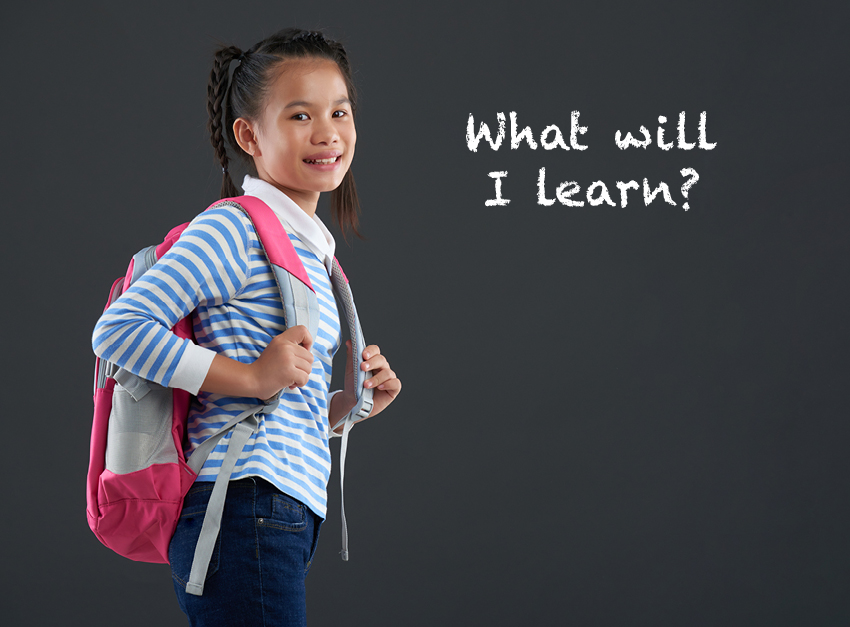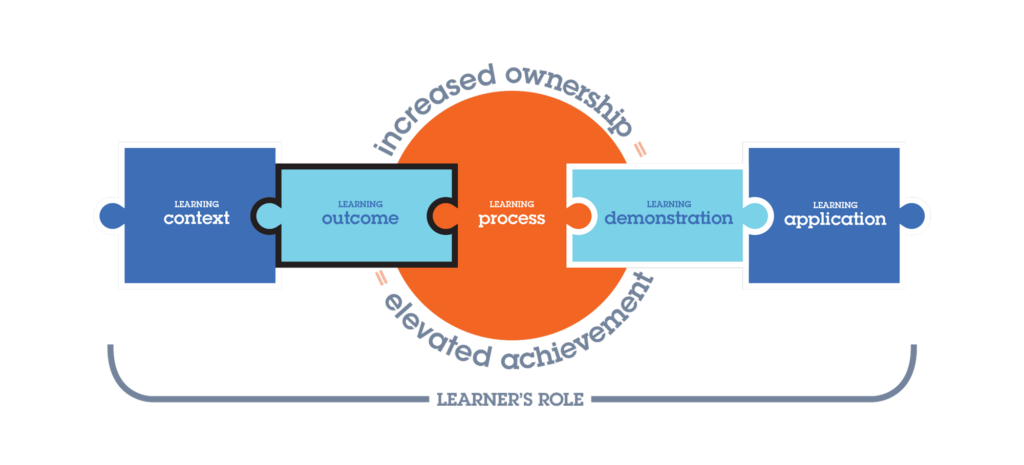Share this article.
This article is part of a series about how to drive authentic, equitable, and sustainable learning by decisions that empower learnership. In other words, the more students know about their learning, the more opportunity they have to own their learning which leads to increased student achievement. Elevated Achievement’s Learning Model is the tool teachers need to support students in ownership of their learning, thereby developing learnership.
In other articles in this series, we provided an overview of the Learning Model and its five student-centered phases: setting the Learning Context, stating the Learning Outcome, engaging in the Learning Process, producing the Learning Demonstration, and implementing the Learning Application. We also discussed the sequence of “backwards” planning a focused lesson and provided examples.
In this article we will take an in-depth look at one of the five phases that lead to increased ownership and elevated achievement, the Learning Outcome.
Determining the Learning Outcome
This is the phase of the lesson during which students specifically understand what they will be learning and how they will show they have learned it. During this phase, the teacher explains WHAT the students will be learning (the skill of the standard) and HOW they will SHOW that they have learned (a demonstration or product). Students will struggle with the learning if they are not clear on how to answer the question, “What will I learn?”
While stating the Learning Outcome, the learning can be written in a variety of ways—as a learning intention with success criteria, as a learning goal, as an objective, or as one part of a larger unit. The learning outcome should be stated, written, discussed, or addressed as determined by student needs. Students will have the opportunity to produce or demonstrate the learning of this outcome during the Learning Demonstration phase.
The Value to Students
If students know what they are learning they are more able to…
- Understand and articulate what specific skill or content they will be learning during the lesson.
- Connect this lesson’s learning with previous learning and an identified future application.
- Understand and articulate how they will know that they have learned, via a demonstration or product, by the end of the lesson.
The Value to Teachers
Teachers who have a classroom full of students who can articulate what they are learning will have students that….
- Make connections from previous learning to the lesson outcome and how together this will support them in future learning and application.
- Take ownership of where they are in learning the skill or content during the lesson and can articulate what differentiated or additional supports they may need to meet the identified learning demonstration.
- Are more motivated to learn as they see value and progress in meeting the identified learning demonstration of the lesson.
In other words, the value to you is to have a classroom of learners who understand their role in the learning and will help you with the task of teaching. Instead of just one person monitoring all of the learning, you will have a roomful of people.
To help you make stronger student-centered decisions, consider these questions as you plan:
- What skill will the students learn?
- What will the students do to show that they have learned this skill?
- What is the student’s role in the Learning Outcome?
- How will you share this information with your students before, during, and after a lesson?
In turn, students who own their learning can articulate before, during, and after a lesson:
- What will I learn?
- What am I learning?
- What did I learn?
What’s Next in Learnership?
As we’ve said before, teachers play a crucial role in ensuring that students own their learning. The teacher is the key decision-maker for establishing effective learning designs before, during, and after instruction in the classroom. Because the teacher is the person who knows the most about the students, it is important that the teacher’s ownership in making these decisions is cultivated.
That’s why we provide 5 articles that take in-depth looks at the each of the phases of the Learning Model, their value to students, and their value to teachers. In each article, you will get the planning questions and tools you need to implement focused Learning Models for each and every lesson.
Remember, the decision-making sequence for designing a lesson is “backwards.” Therefore, the following sequence for reading is recommended as you plan with a focused Learning Model.
- First, make sure you’ve read the articles, “How to Set Out for Your Students Why This Learning Is Important” and “How to Ensure Your Students Apply What They Have Learned” so you know how to determine the Learning Context and the Learning Application. In other words, read these 2 articles to get the planning questions and tools you need to determine why students are learning a skill right now and how they will use it in the future.
- Next, read this current article to learn how to determine the Learning Outcome, and then read “How to Empower Your Students to Demonstrate Their Learning” to learn how to determine the Learning Demonstration. In other words, read these 2 articles to get the planning questions and tools you need to determine the specific skills students are learning and what a demonstration of mastery will look and sound like.
- Finally, read “How to Engage Your Students in the Learning Process” to learn how to determine the Learning Process. In other words, read this article to get the planning questions and tools you need to determine the instructional strategy or strategies that will allow for students to most effectively and efficiently demonstrate mastery of the targeted skill.
Then you’ll be ready to backwards plan a lesson and forward instruct through that lesson with the end in mind as you move through the five student-centered phases: setting the Learning Context, stating the Learning Outcome, engaging in the Learning Process, producing the Learning Demonstration, and implementing the Learning Application.
Continue the Learning
Check out these articles and resources to continue your learning about this topic…
The Learning Brief
In this article you learned…
- The Learning Outcome is the phase of the lesson during which students specifically understand what they will be learning and how they will show they have learned it.
- The learning outcome should be stated, written, discussed, or addressed as determined by student needs, and students will have the opportunity to produce or demonstrate the learning of this outcome during the Learning Demonstration
- Teachers who have a classroom full of students who can articulate what skill they are learning will have students that buy-in to their learning as they see value and progress in meeting the identified learning demonstration of the lesson.
Can you imagine building an environment full of motivated, engaged, and eager students who own their learning?
We can.


